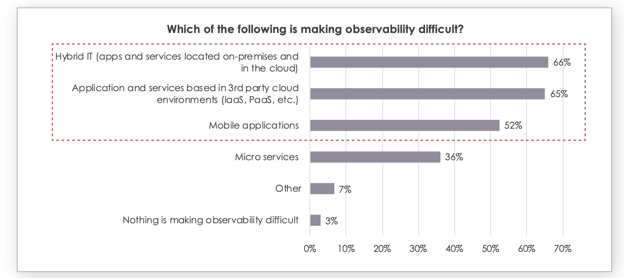Hybrid cloud holds a lot of promise for enterprises that are looking to get the best of both worlds. They get modern cloud technologies and can salvage their investment in legacy infrastructure and operations.
A hybrid cloud is a combination of public cloud and private cloud infrastructure. While this possibility is exciting, realizing its full benefits requires an advanced monitoring practice. Hybrid cloud monitoring requires AIOps (Artificial intelligence in IT operations). In this post, we look at four best practices to improve hybrid cloud monitoring.
According to a recent study by Dimensional Research, monitoring and operating hybrid cloud systems is one of the top factors making observability difficult.

Figure 1: A Dimensional Research study found that a hybrid cloud environment makes observability difficult.
Specifically, gaining end-to-end visibility across hybrid cloud and third-party cloud infrastructures.
Indeed, in the rush to go cloud, many organizations find that their cloud monitoring tools are only compatible with one cloud vendor or with a couple of public cloud platforms, but not with their private cloud or on-prem environments. This poses a big problem for organizations looking to gain an end-to-end view of the system.
Following are four best practices for monitoring hybrid cloud environments.
1. Separate and Monitor with Microservices
To make the most of hybrid cloud, your apps will need to be nimble enough to allow for services to be moved between clouds. In terms of monitoring, microservices bring deeper visibility into every layer of the applications stack. They allow you to view services independently and in relation to other services. They separate applications from infrastructure and networking, and so on.
Once an issue is identified, microservices make it easier to pinpoint the root cause and even rectify it. For example, an issue that affects users in one region can be resolved without affecting users in other regions.
2. Monitor Continuously Across Public and Private Clouds
A hybrid cloud benefits both workloads that require the security and exclusivity of a private cloud and those that are best run in the public cloud. The key is to know which to run where.
A private cloud is ideal for applications that have specific requirements for compliance, performance, and security (or security that public clouds are unable to meet). The public cloud is great for apps that are built from scratch and for apps that need cloud burst capabilities.
Some apps can be run on a combination of public and private cloud infrastructure. For example, you could use the public cloud to run the application, as it can easily scale to meet demand; and use the private cloud for data storage for that added layer of security.
When it comes to monitoring these workloads, apps that are run on both public and private cloud infrastructure are the most challenging as the workload spans both private and public cloud. An AIOps monitoring tool that can report on the whole picture makes management of the apps easier. Further, as workloads shift between private and public clouds, the AIOps monitoring tool should be aware of these changes all the while continuously monitoring.
3. Unify Infrastructure
While hybrid cloud is inherently distributed, how distributed it is depends on the business requirements and the preferred architecture. This has bearing on how many cloud vendors make up the spread of hybrid cloud environments.
One organization may prefer to use a mix of many cloud vendors and services. This is the best-of-breed approach where you stop at nothing in your quest for the perfect cloud experience. For example, you may want to opt for a smaller cloud vendor to leverage their expertise with OpenStack or a particular vendor's serverless platform for its ease of use. You may value the ability to change vendors in the future, and may not want to commit too much to a single vendor. An AIOps monitoring tool can help here because it can adapt to your changing infrastructure requirements.
The other approach is to centralize on a single cloud vendor. The big three cloud vendors - AWS, Azure, and Google Cloud - would be an ideal choice for this setup. They have been making conscious efforts to strengthen their hybrid cloud offerings of late and each has announced a major focus on hybrid cloud solutions with their services like Google Anthos, Azure Arc, and AWS Outposts.
These services enable the creation and management of resources across the cloud platform and on-premises. However, they will provide only basic monitoring; beyond which, you'll need a more robust AIOps monitoring tool that can provide in-depth and advanced monitoring capabilities.
4. Integrate Monitoring Tools
The hybrid cloud model is made up of a mix of containers, VMs, and physical servers. There is a mix of traditional IT and modern cloud-native networking and storage components to be monitored alongside each other. They are best managed via policies rather than manual configuration. Policies enable you to achieve SLOs while maintaining the scale and diversity of the hybrid cloud.
The key to implementing and maintaining policies across the stack is monitoring. It takes an AIOps monitoring tool to gather all meaningful monitoring data from various disparate sources, bring them together, and extract meaningful insight from them.
By integrating monitoring tools using AIOps, ad-hoc analysis is simplified which is essential for troubleshooting and day-to-day monitoring operations. Practically, this allows users to throw different metrics into the AIOps tool and view them in a single dashboard.
Importantly, you should be able to do this in a matter of seconds, or at most, minutes. This speed is critical when incidents occur. Having the right monitoring data and the capability to analyze it to identify the root cause is when the rubber meets the road. A modern AIOps monitoring tool excels at separating the signal from the noise and suppresses false alarms.
Further, modern AIOps has a mature alerting and notifications system so that the right people are informed at the right time. This tool helps to bring together diverse teams in one place and enables them to 'speak the same language.'
AIOps is ideally positioned to be the default solution for hybrid cloud monitoring: it makes sense of the complexity of hybrid cloud environments. As you make the journey from on-premise to hybrid cloud, ensure you have a capable AIOps monitoring tool to rely on at every step of the way.
Visit Broadcom’s Enterprise Software Academy for resources on hybrid cloud monitoring and application performance monitoring.

Twain Taylor
Twain Taylor is a technology analyst and contributing writer at Fixate IO.
Other resources you might be interested in
Top 3 Trends Defining Network Observability in 2026
Discover the three specific trends that will define network observability in 2026. See how unified observability and predictive AI will shape the landscape.
Rally Office Hours: December 18, 2025
Rally Office Hours features an AI-driven artifact breakdown tool that creates child items from features/stories. The Q&A covers capacity planning, forecasting and burnup charts.
Why 2025 Shattered the Old Rules of Network Management
This post reveals the five key lessons network operations leaders learned in 2025—and how they need to respond to be successful in 2026.
The 2026 VMUG Report: Why Network Observability is the Heart of the New VCF Era
Get the top takeaways from the VMUG Cloud Operations and VCF User Experience Report 2026. See why network observability is key to successful VCF 9 migrations.
Automic Automation Cloud Integration: SAP S/4 HANA Application Jobs Integration
Simplify your SAP S/4HANA job management. Integrate with Automic Automation for central configuration, monitoring, and orchestration of all your enterprise jobs.
Automic Automation Cloud Integration: OpenSSH Integration
Master Open SSH automation. Use Automic Automation for centralized control, secure file transfer, command execution, and full job monitoring.
Rally Office Hours: December 11, 2025
Discover Rally's new Ancestors field, static query box deprecation, non-conflicting saves, plus a dashboard demo and query writing tips.
3 Questions I Expect You to Ask Me
Ask these questions to gain a deeper understanding of a vendor. Find a partner who can solve today’s challenges and prepare you for what’s next.
Carrier-Grade Network Observability: A Technology Brief for Telco Network Operations
Network Observability by Broadcom unifies data to provide contextual, AI-enabled insights for superior service availability, accelerated MTTR and improved MTTI, reduced operational costs, and the...